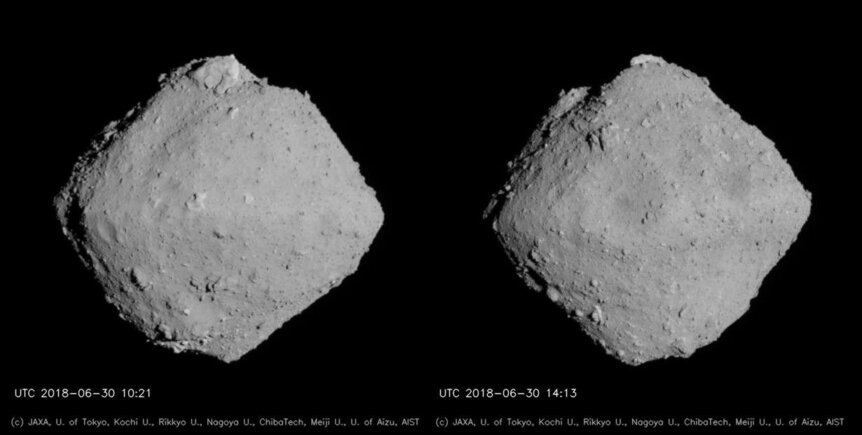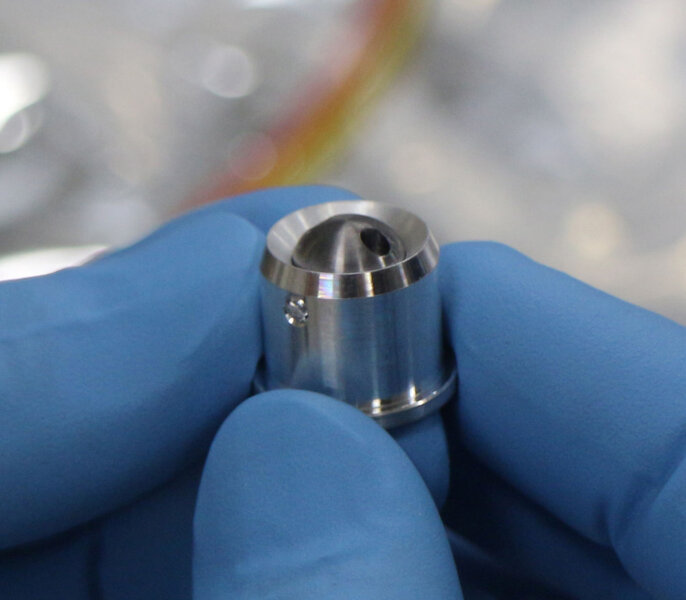Create a free profile to get unlimited access to exclusive videos, sweepstakes, and more!
AMAZING video: Hayabusa-2 shot a bullet at an asteroid and collected the shrapnel

Last week, on February 21, 2019, the Japanese space probe Hayabusa2 began to descend upon its target. Drifting in at less than a meter per second — slower than walking speed — the spacecraft approached the asteroid Ryugu. Then, just as it made contact, it shot a high-speed bullet into the surface, dislodging rocks and sending them flying!
The purpose: Catch one of those rocks and/or the dust surrounding it, secure it in a sampling container, and eventually return it to Earth.
Cool, right? Yeah, well watch this video and tell me if that word is big enough:
Coooooooool. I don’t know what’s the best part of this: The slow, agonizing descent, the details getting clearer as it approaches, the shadow growing larger and larger, the sudden bounce off the surface, or the incredible explosion of rocks scattering everywhere.
OK, fine: It’s the rocks. So what is all this?
Ryugu is a small asteroid about a kilometer across. The best description I can think of is that it’s shaped like two Apollo capsules stuck bottom-to-bottom: Two squat cones with the bottoms forming the equator. It’s a rubble pile asteroid, basically a bag of rocks held together by their own gravity. We think many if not most small asteroids are like this; countless low speed collisions with other small asteroids over billions of years have created deep fissures in the asteroid, and pulverized a lot of the material. The surface is completely covered with rocks from big boulders down to grains finer than sand.
Hayabusa2 entered Ryugu’s space in June 2018. It’s taken a vast amount of data of the asteroid, including sending down a pair of rovers and a small lander to get close up images and measure other interesting characteristics. In November it even dipped down low over the surface in a practice approach run.
This is all very important, but the big prize is collecting samples of the. It’ll grab samples three times, and this is the first.
Just as the probe touched the surface, it shot a 5-gram bullet made of tantalum at a speed of about 300 meters per second — over a thousand kilometers per hour, faster than a jet plane — into the asteroid. This scattered debris everywhere (as you saw very dramatically) and hopefully some of it made it in to the horn-shaped sample collector located on the underside of the spacecraft (there’s no way to know for sure, but given that footage, it looks like a pretty good bet). The material collected will be secured inside a sample-return capsule, which will be sent back to Earth in 2020.
That way, scientists here can study the samples in sophisticated labs, using the most modern equipment to figure out just what this asteroid is made of and what its history is, hopefully giving us insight into how asteroids behave.
Why tantalum for the bullet? Because it’s so rare that if a piece of it gets into the sample scientists will know right away it was from the bullet and not the rock. If they used something common, like iron, there wouldn’t be a way to distinguish it from the native materials.
And Hayabusa2 is not done yet. There’s another surface sample event planned, as well as an ambitious subsurface sample mission: It’ll deploy what is essentially a floating cannon that will fire a much more energetic 2.5 kilogram copper projectile into Ryugu, overturning the material sitting on top and digging up stuff from below (the spacecraft itself will maneuver to the other side of the asteroid for safety… and again, copper is used to distinguish it from the sample material). Once things settle down, Hayabusa2 will come back to that site and gather a sample from the crater left by the impactor. This is planned for April.
Once all three samples are secure, it’ll leave the asteroid (planned for December) and head back to Earth. As it approaches us a year later, it’ll release the sample-return capsule which will then parachute down in Australia to awaiting scientists.
So take another look at that video above. Those are pieces of an asteroid flying away, some perhaps launched into their own orbits around the Sun… but hopefully one such small piece was snagged by Hayabusa2. In less than two years scientists back here on Earth will be able to get their hands on them, and we’ll learn a whole lot about what makes small asteroids tick.






























